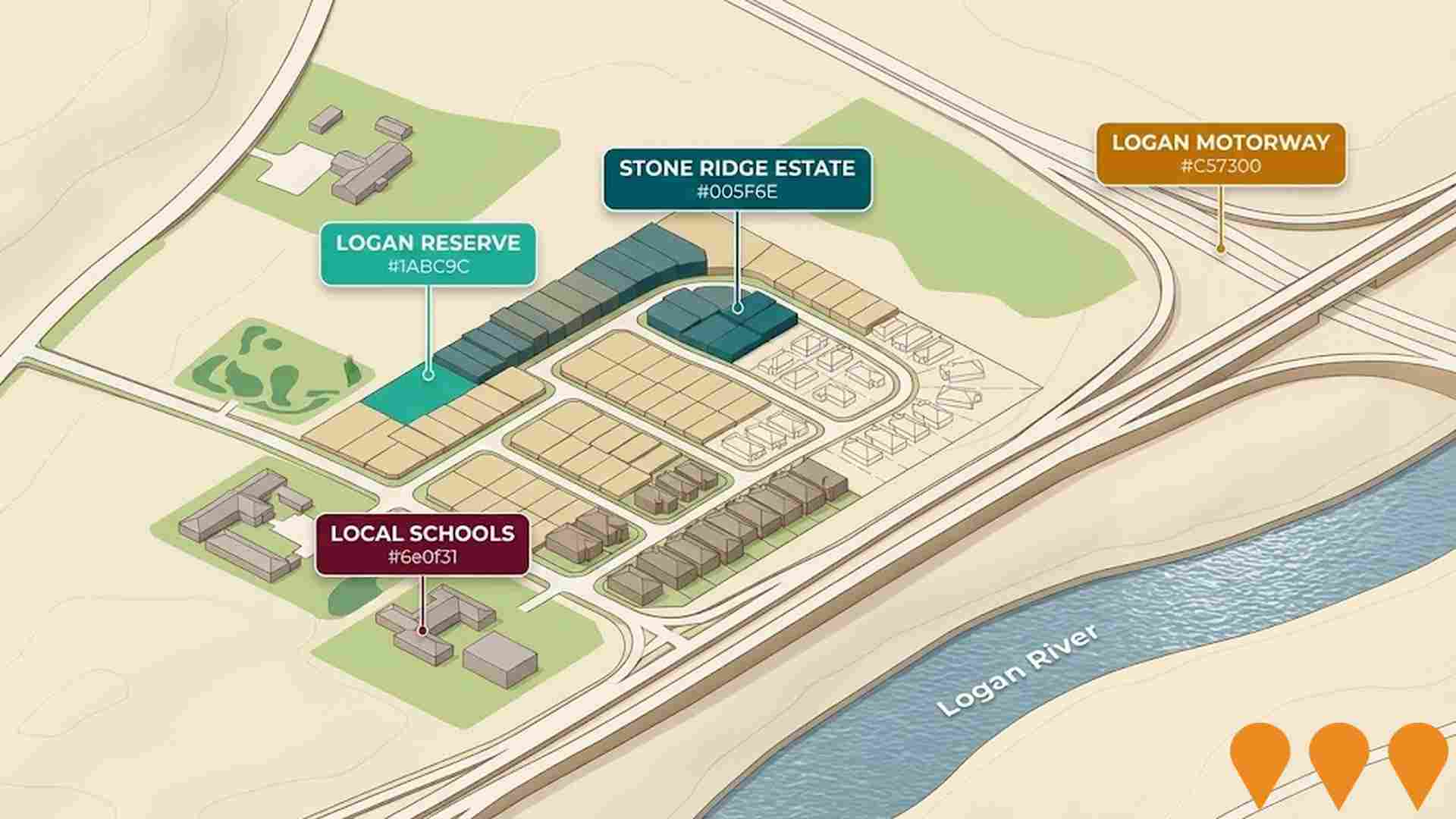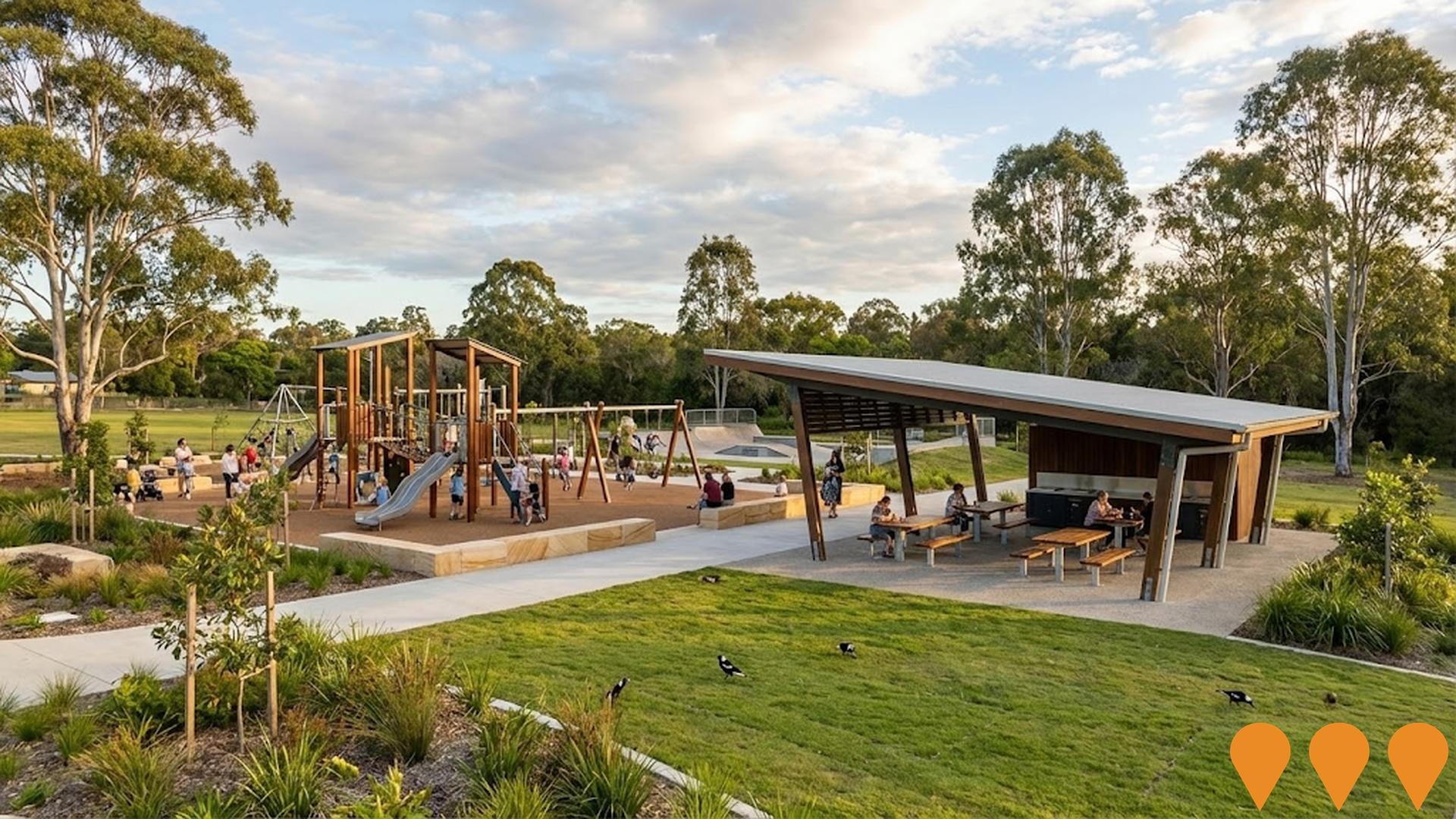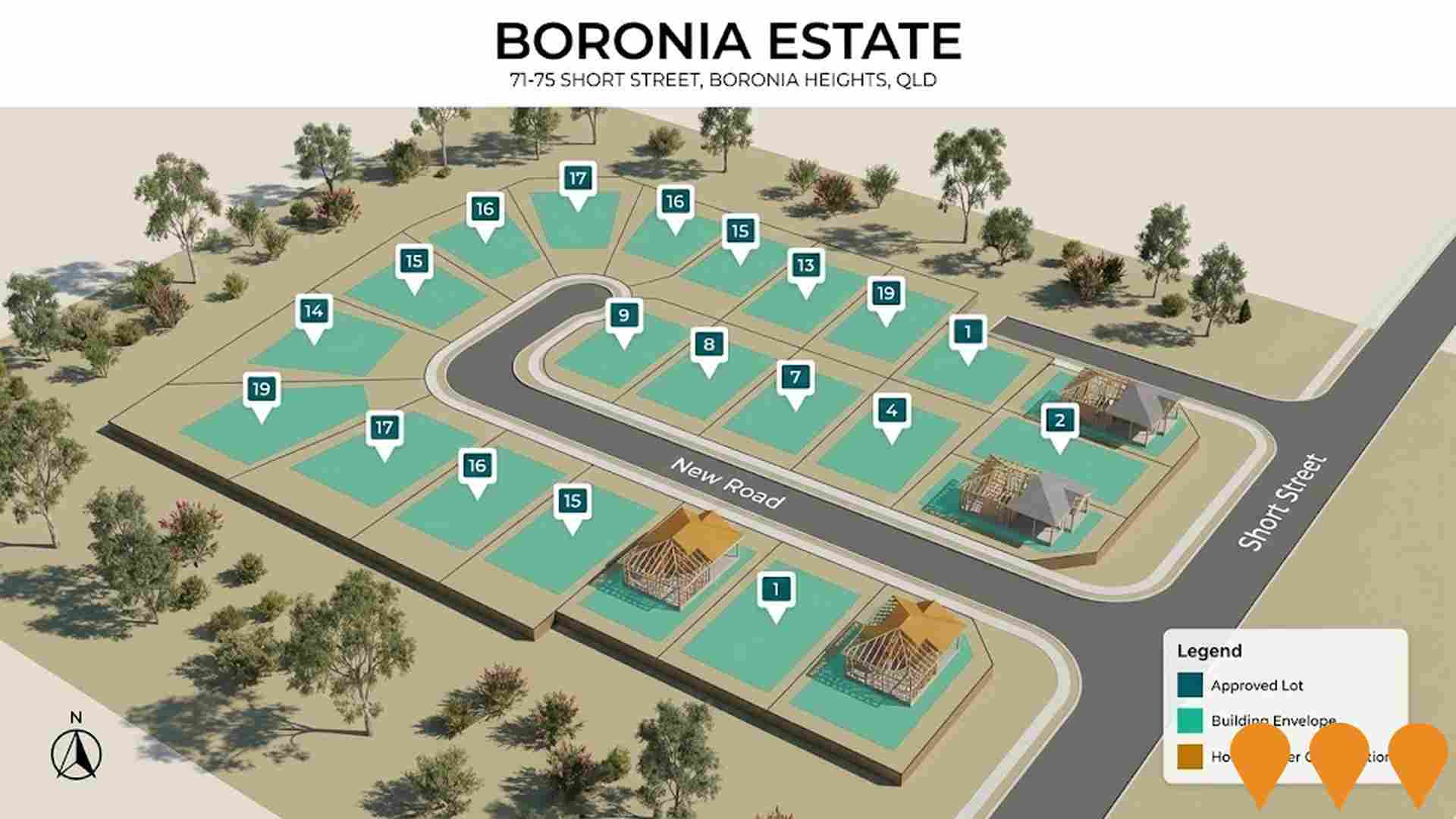Chart Color Schemes
est. as @ -- *
ABS ERP | -- people | --
2021 Census | -- people
Sales Activity
Curious about local property values? Filter the chart to assess the volume and appreciation (including resales) trends and regional comparisons, or scroll to the map below view this information at an individual property level.
Find a Recent Sale
Sales Detail
Population
Boronia Heights - Park Ridge lies within the top 10% of areas nationally in terms of population growth performance according to AreaSearch analysis of short and medium-term trends
Boronia Heights - Park Ridge's population was around 28,336 as of August 2025. This figure reflects an increase of 9,170 people since the 2021 Census, which reported a population of 19,166. The change was inferred from the estimated resident population of 25,707 in June 2024 and an additional 2,695 validated new addresses since the Census date. This results in a density ratio of 886 persons per square kilometer. Boronia Heights - Park Ridge's growth rate of 47.8% since the 2021 census exceeded both national (8.6%) and state averages, marking it as a growth leader in the region. Interstate migration contributed approximately 81.7% of overall population gains during recent periods.
AreaSearch adopts ABS/Geoscience Australia projections for each SA2 area, released in 2024 with 2022 as the base year. For areas not covered by this data and years post-2032, Queensland State Government's SA2 area projections are adopted, released in 2023 based on 2021 data. Exceptional growth is predicted over the period to 2041, with the area expected to grow by 17,725 persons, reflecting an increase of 53.3% in total over the 17 years.
Frequently Asked Questions - Population
Development
The level of residential development activity in Boronia Heights - Park Ridge was found to be higher than 90% of real estate markets across the country
Boronia Heights - Park Ridge averaged approximately 627 new dwelling approvals annually over the past five financial years, from FY-21 to FY-25, totalling 3,137 homes. In FY-26, up until now, there have been 144 dwellings approved. This has resulted in an average of 3.1 new residents per year arriving for each dwelling constructed over the same period.
Consequently, demand significantly exceeds supply, leading to price growth and increased buyer competition. The average development value for new dwellings is $361,000, which is below the regional average, suggesting more affordable housing options for buyers. This financial year has seen $51.5 million in commercial development approvals, indicating robust local business investment. When compared to Greater Brisbane, Boronia Heights - Park Ridge shows 95.0% higher construction activity per person, offering buyers greater choice, although development activity has moderated recently. This activity is significantly above the national average, reflecting strong developer interest in the area.
New development consists of 85.0% standalone homes and 15.0% townhouses or apartments, preserving the area's low density nature with an emphasis on detached housing that attracts space-seeking buyers. Currently, there are around 54 people per approval, indicating a developing area. Population forecasts project Boronia Heights - Park Ridge to gain approximately 15,096 residents by 2041. If development rates continue at the current pace, new housing supply should comfortably meet demand, providing good conditions for buyers and potentially supporting growth beyond current population projections.
Frequently Asked Questions - Development
Infrastructure
Boronia Heights - Park Ridge has moderate levels of nearby infrastructure activity, ranking in the 47thth percentile nationally
Area infrastructure changes significantly influence local performance. AreaSearch identified 60 projects impacting the area. Notable ones include Park Lane Reserve (formerly Park Ridge Master Planned Community), Queensland Energy Roadmap Infrastructure, Madison Park Estate, and Chambers Flat Road Upgrade (Park Ridge Road to Derby Road). The following list details those most relevant.
Professional plan users can use the search below to filter and access additional projects.
INFRASTRUCTURE SEARCH
 Denotes AI-based impression for illustrative purposes only, not to be taken as definitive under any circumstances. Please follow links and conduct other investigations from the project's source for actual imagery. Developers and project owners wishing us to use original imagery please Contact Us and we will do so.
Denotes AI-based impression for illustrative purposes only, not to be taken as definitive under any circumstances. Please follow links and conduct other investigations from the project's source for actual imagery. Developers and project owners wishing us to use original imagery please Contact Us and we will do so.
Frequently Asked Questions - Infrastructure
Queensland Energy Roadmap Infrastructure
The Queensland Energy Roadmap 2025 is the State Government's strategic plan to deliver affordable, reliable, and sustainable energy. Replaces the former Energy and Jobs Plan, focusing on extending the life of state-owned coal assets, a $1.6 billion Electricity Maintenance Guarantee, and the $400 million Queensland Energy Investment Fund. Key infrastructure includes the CopperString transmission line and new gas-fired generation, while the Pioneer-Burdekin Pumped Hydro project has been cancelled in favor of smaller storage options.
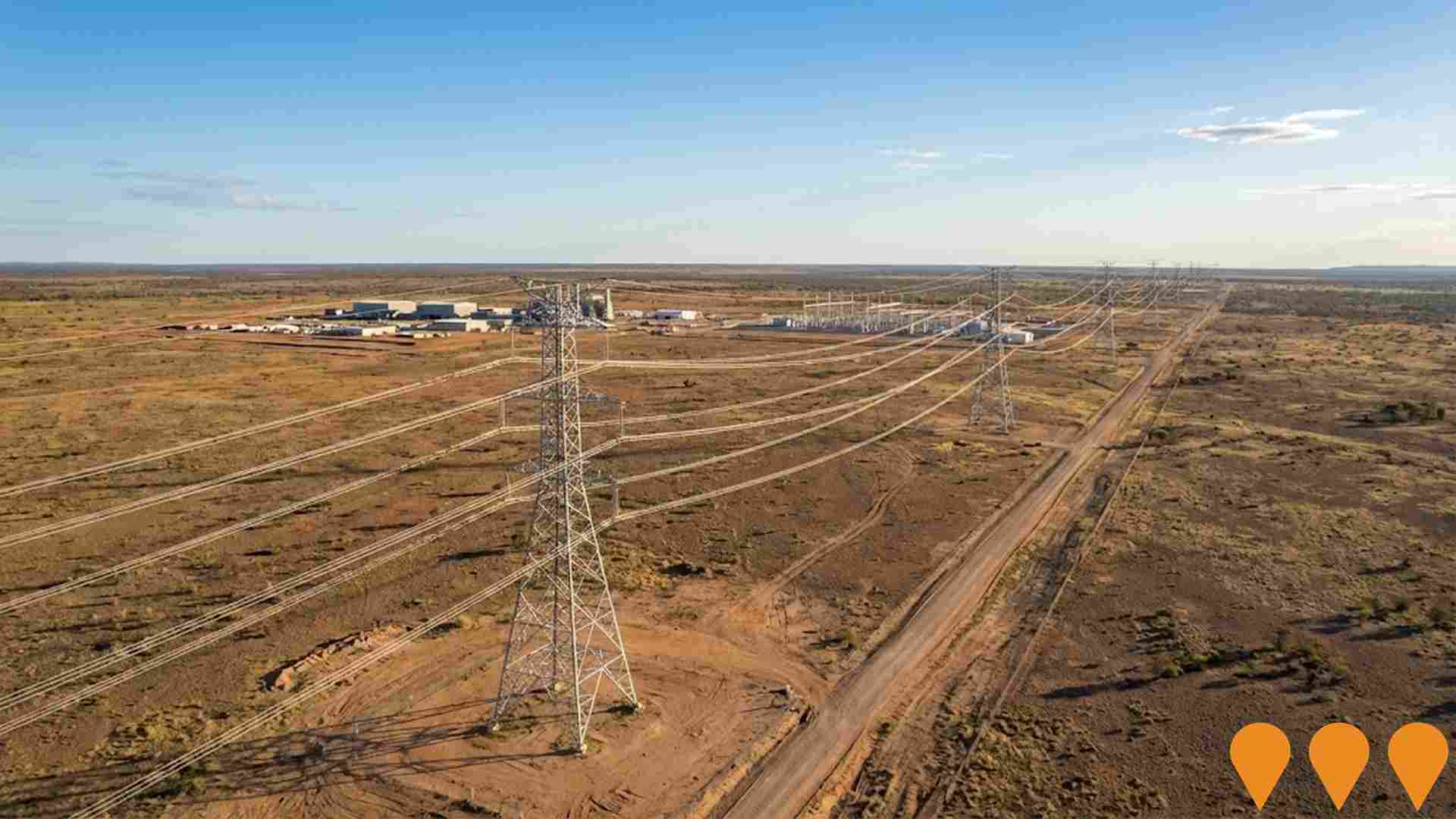
Crestmead Logistics Estate
A $1.5 billion nine-stage industrial estate developed by Pointcorp, delivering 650,000 sqm of warehousing, business, logistics and manufacturing space across 157 hectares. The project is a major industrial growth engine for the south-western Brisbane corridor. Stage 1 was completed and purchased by Mapletree Investments for $90 million to develop a $440 million Mapletree Logistics Park. Stage 2 of Mapletree Logistics Park, adding 37,751 sqm, was due for completion in October 2023, with Stage 3 construction commencing for March/April 2025 occupancy.

Park Ridge Village
Park Ridge Village is a greenfield development that will provide convenient roadside retail for the local community of Park Ridge. The development will be designed to meet the needs and desires of the growing Logan LGA community by providing its customers with a wide range of services and amenities. The project will comprise a mix of commercial spaces, including retail outlets, restaurants, and service providers, offering a convenient shopping experience with ample parking and easy access.

Park Ridge Town Centre
Dual-supermarket anchored neighbourhood shopping centre featuring Woolworths and Coles supermarkets, over 30 specialty stores, KFC, and Ampol fuel site. Includes a 13,000sqm extension completed in 2016 with large civil works over 100,000m3. Sold in 2023 for $86 million to Chin Hong Group.
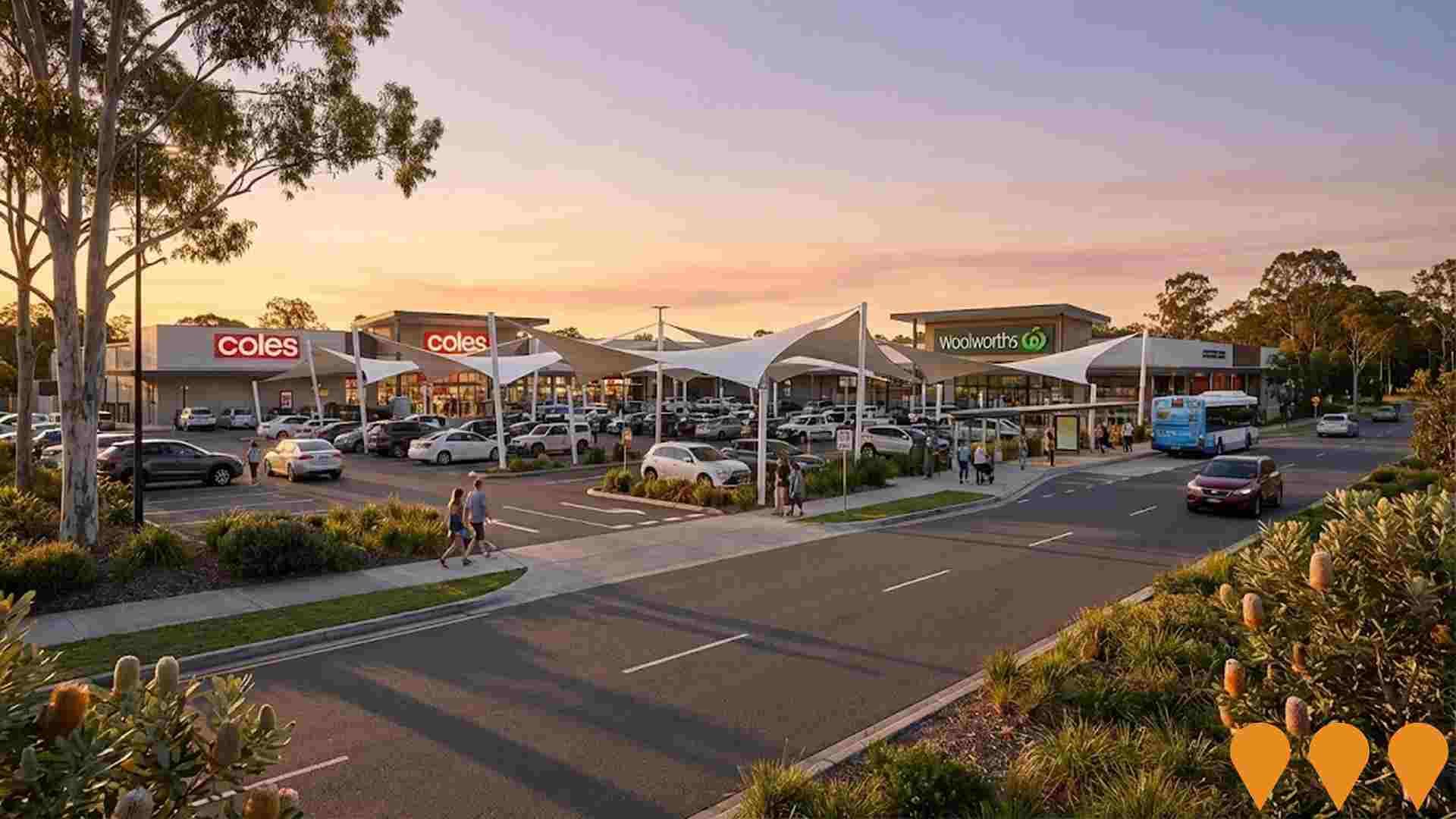
Logan Reserve Combined State School
A new combined primary and secondary state school in Logan Reserve to accommodate the growing local population. The school will include modern classrooms, technology-enabled learning spaces, a performing arts center, and community facilities to support education and local engagement.

Park Lane Reserve (Formerly Park Ridge Master Planned Community)
A 185-lot residential subdivision co-developed by GDM Property and Choice Homes, located in Logan Reserve (formerly marketed more broadly as Park Ridge). The community offers house and land packages and includes a new park and recreation facilities. Stage 3A is currently being sold with a proposed registration date of December 10, 2025.
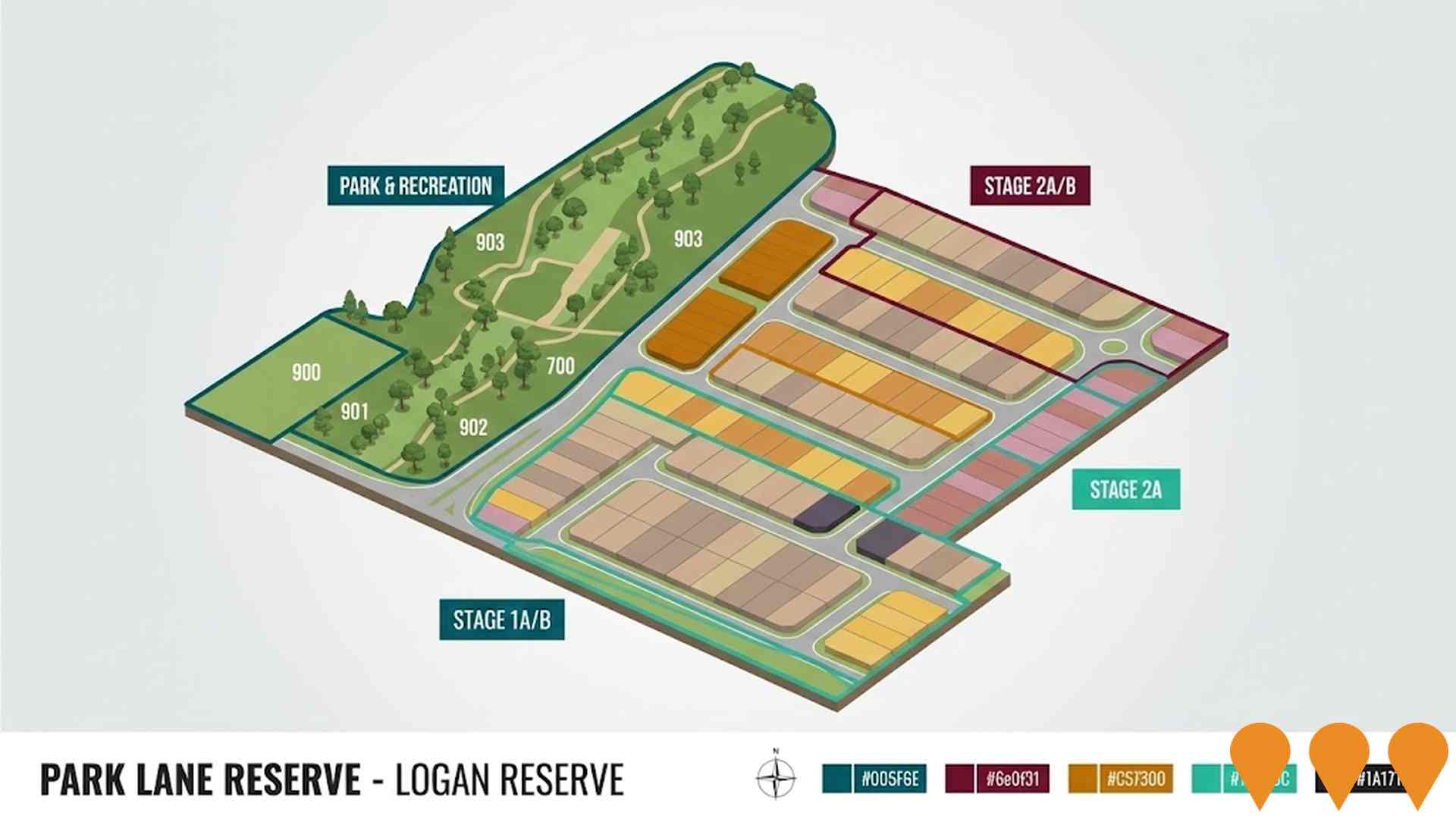
Madison Park Estate
This exciting new residential community is perfectly positioned within Park Ridge, a vibrant and well-connected urban location in South East Queensland. Relax and enjoy everything life has to offer right on your doorstep, with employment, education facilities, shopping and medical facilities right around the corner. Set in picturesque, tree-lined streets, Madison Park is the ideal place to raise your family, in a friendly, community-oriented neighborhood.
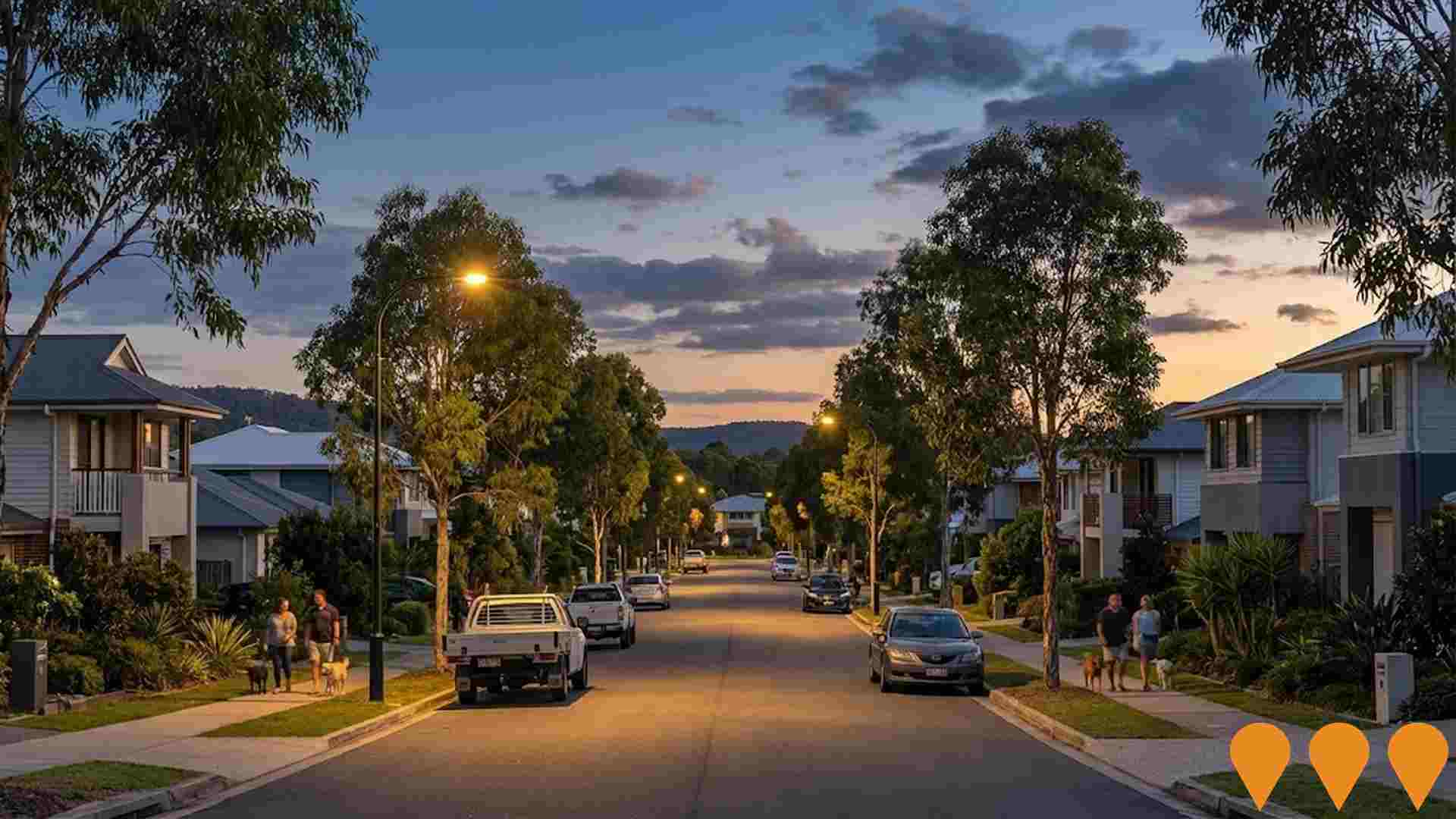
Alto Park Ridge
Alto Park Ridge is a boutique family-friendly residential estate in Park Ridge, QLD, featuring 56 lots with a community park. Located at 52 Lindenthal Road, it offers convenient access to local amenities, schools, and major road networks, just 6 minutes from Park Ridge Town Centre. Civil works are set to commence shortly.

Employment
AreaSearch analysis indicates Boronia Heights - Park Ridge maintains employment conditions that align with national benchmarks
Boronia Heights - Park Ridge has a balanced workforce with both white and blue collar jobs. Manufacturing and industrial sectors are prominent.
The unemployment rate was 3.9% in June 2025, below Greater Brisbane's 4.1%. Employment grew by 5.4% over the past year. As of June 2025, 12,783 residents were employed with a participation rate of 60.3%, lower than Greater Brisbane's 64.5%. Key industries include health care & social assistance, retail trade, and construction.
Transport, postal & warehousing is particularly strong at 1.8 times the regional level, while professional & technical services are underrepresented at 4.2% versus the regional average of 8.9%. Employment opportunities locally may be limited as indicated by Census data. Between June 2024 and June 2025, employment levels increased by 5.4%, labour force by 4.8%, reducing unemployment by 0.5 percentage points. Greater Brisbane recorded similar growth trends but at slightly lower rates. National employment forecasts from Jobs and Skills Australia (May 2025) project national growth of 6.6% over five years and 13.7% over ten years, with varying industry-specific projections. Applying these to Boronia Heights - Park Ridge's employment mix suggests local growth of approximately 6.0%% over five years and 12.8% over ten years.
Frequently Asked Questions - Employment
Income
Income levels sit below national averages according to AreaSearch assessment
AreaSearch's latest postcode level ATO data for financial year 2022 shows Boronia Heights - Park Ridge had a median income among taxpayers of $52,258 and an average of $58,841. This is below the national average. Greater Brisbane's median income was $55,645 with an average of $70,520. Based on Wage Price Index growth of 13.99% since financial year 2022, estimated current incomes would be approximately $59,569 (median) and $67,073 (average) as of September 2025. Census data indicates household, family, and personal incomes in Boronia Heights - Park Ridge rank modestly, between the 34th and 37th percentiles. The largest income segment comprises 36.5% earning $1,500 - $2,999 weekly (10,342 residents), similar to regional levels where 33.3% occupy this range. Housing affordability pressures are severe, with only 81.1% of income remaining, ranking at the 30th percentile.
Frequently Asked Questions - Income
Housing
Boronia Heights - Park Ridge is characterized by a predominantly suburban housing profile, with above-average rates of outright home ownership
Boronia Heights - Park Ridge had 86.2% houses and 13.7% other dwellings in the latest Census, compared to Brisbane's 89.2% houses and 10.9% other dwellings. Home ownership was at 24.2%, with mortgaged dwellings at 31.9% and rented ones at 43.9%. The median monthly mortgage repayment was $1,616, higher than Brisbane's $1,600 but lower than the national average of $1,863. The median weekly rent was $360, matching Brisbane's figure but lower than the national average of $375.
Frequently Asked Questions - Housing
Household Composition
Boronia Heights - Park Ridge has a typical household mix, with a lower-than-average median household size
Family households account for 73.5% of all households, including 31.0% couples with children, 25.8% couples without children, and 15.4% single parent families. Non-family households make up the remaining 26.5%, with lone person households at 22.8% and group households comprising 3.7%. The median household size is 2.7 people, which is smaller than the Greater Brisbane average of 3.0.
Frequently Asked Questions - Households
Local Schools & Education
Boronia Heights - Park Ridge shows below-average educational performance compared to national benchmarks, though pockets of achievement exist
The area's university qualification rate is 16.3%, significantly lower than Greater Brisbane's average of 30.5%. Bachelor degrees are the most common at 11.1%, followed by postgraduate qualifications (3.7%) and graduate diplomas (1.5%). Vocational credentials are prevalent, with 40.9% of residents aged 15+ holding them - advanced diplomas (10.5%) and certificates (30.4%). Educational participation is high, with 30.5% of residents currently enrolled in formal education: 11.5% in primary, 8.0% in secondary, and 3.8% in tertiary education.
Six schools operate within Boronia Heights - Park Ridge, educating approximately 3,840 students. The area has balanced educational opportunities (ICSEA: 993), with a mix of three primary, one secondary, and two K-12 schools.
Frequently Asked Questions - Education
Schools Detail
Nearby Services & Amenities
Transport
Transport servicing is low compared to other areas nationally based on assessment of service frequency, route connectivity and accessibility
Boronia Heights - Park Ridge has 59 active public transport stops, all of which are bus stops. These stops are served by 8 different bus routes that collectively facilitate 922 weekly passenger trips. The accessibility to these transport services is rated as limited, with residents typically located 637 meters from the nearest stop.
On average, there are 131 trips per day across all routes, which translates to approximately 15 weekly trips per individual stop.
Frequently Asked Questions - Transport
Transport Stops Detail
Health
Health performance in Boronia Heights - Park Ridge is lower than average with common health conditions somewhat prevalent across the board, though to a considerably higher degree among older age cohorts
Boronia Heights - Park Ridge faces significant health challenges with common health conditions being somewhat prevalent across the board, particularly among older age cohorts. The rate of private health cover is relatively low at approximately 49% of the total population (~13,912 people), compared to the national average of 55.3%.
The most common medical conditions in the area are asthma and mental health issues, impacting 9.0 and 9.0% of residents respectively. However, 67.1% of residents declare themselves completely clear of medical ailments, compared to 69.2% across Greater Brisbane. The area has 13.6% of residents aged 65 and over (3,856 people), which is higher than the 12.2% in Greater Brisbane. Health outcomes among seniors present some challenges requiring more attention than the broader population.
Frequently Asked Questions - Health
Cultural Diversity
Boronia Heights - Park Ridge was found to be more culturally diverse than the vast majority of local markets in Australia, upon assessment of a range of language and cultural background related metrics
Boronia Heights-Park Ridge is more culturally diverse than most local areas, with 24.0% speaking a language other than English at home and 33.2% born overseas. Christianity is the predominant religion, making up 44.0%. The 'Other' religious category comprises 5.4%, higher than Greater Brisbane's 2.7%.
Top ancestry groups are English (26.0%), Australian (22.8%), and Other (13.6%). Maori (2.8%) is notably overrepresented compared to the regional average of 3.2%. Samoan representation is 2.5%, slightly lower than the regional 3.0%. New Zealand ancestry is at 1.3%, lower than the regional 1.5%.
Frequently Asked Questions - Diversity
Age
Boronia Heights - Park Ridge hosts a very young demographic, ranking in the bottom 10% of areas nationwide
Boronia Heights - Park Ridge has a median age of 31 years, which is younger than the Greater Brisbane average of 36 and significantly under the Australian median of 38. Compared to Greater Brisbane, Boronia Heights - Park Ridge has a higher proportion of residents aged 25-34 (18.6%) but fewer residents aged 45-54 (9.4%). According to post-2021 Census data, the population aged 35-44 grew from 12.2% to 14.3%, while the proportion of those aged 65-74 declined from 8.1% to 6.9% and the age group 55-64 dropped from 8.8% to 7.7%. Demographic modeling indicates that Boronia Heights - Park Ridge's age profile will change significantly by 2041, with the 45-54 age cohort projected to increase considerably, expanding by 2,003 people (76%) from 2,652 to 4,656.
